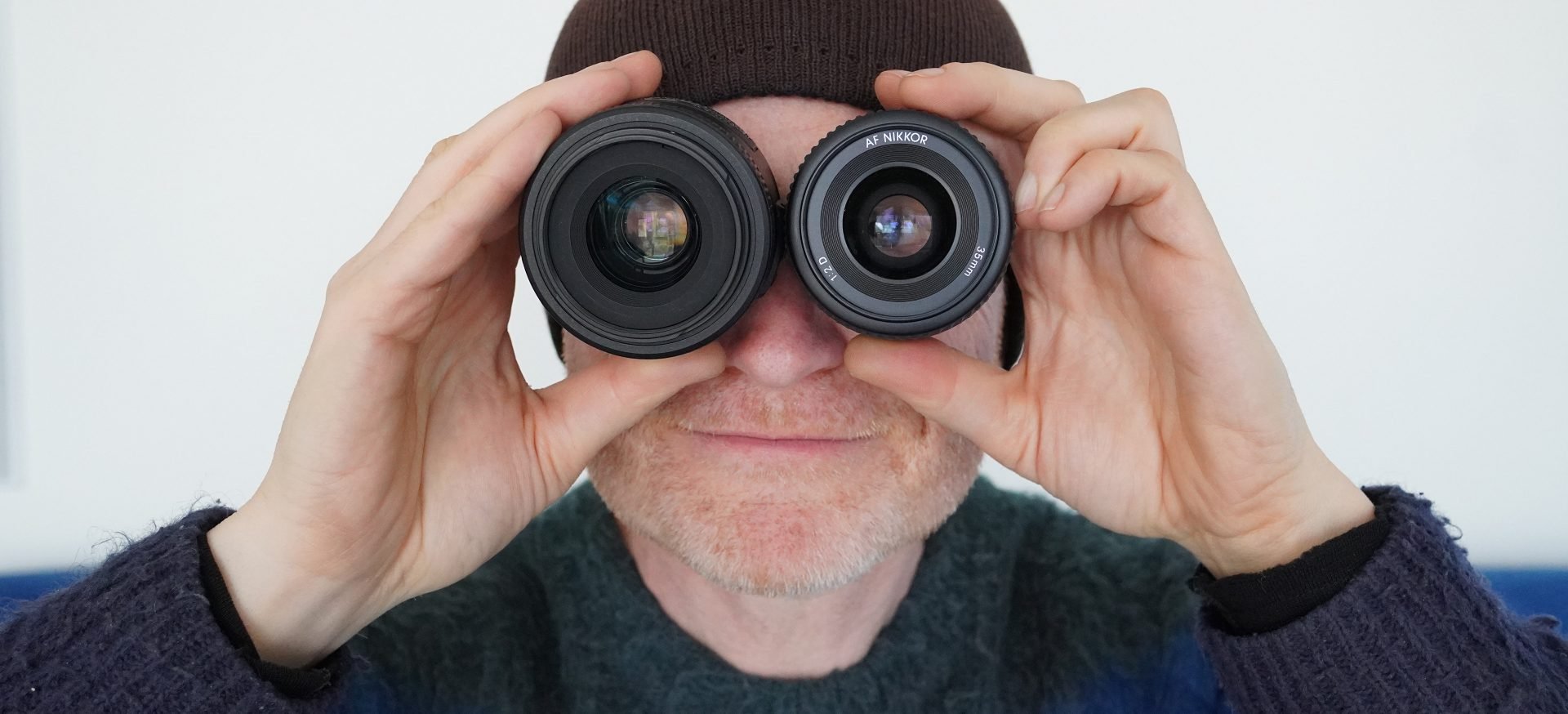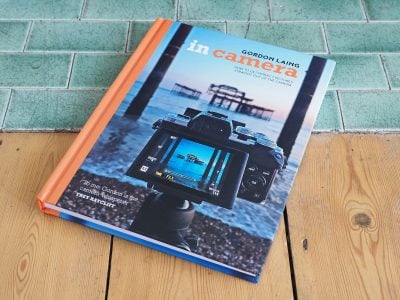Best lens for a vintage DSLR?
-
-
Written by Gordon Laing
In this article I’m tracking down the perfect lens for a vintage DSLR – and not just any DSLR either. Nikon recently loaned me their original D1, the first DSLR they entirely designed and built themselves back in 1999. Coincidentally I’d also recently bagged its successor, the D1x for a review on my retro channel Dino Bytes – check it out if you’re into vintage digital cameras from the 90s and early 2000’s!
Both bodies arrived without a lens, but rather than simply fitting a modern option, I felt they deserved a classier approach befitting their age and importance in digital camera history. I decided the perfect age-appropriate match would be a general-purpose prime lens launched within a decade or so of the bodies.
While the D1 and D1x were announced as flagship cameras, affordable full-frame sensors were still some years away. So both were equipped with smaller APSC-sized sensors, resulting in a 1.5 times field-reduction, so for roughly standard coverage from a prime lens, I’d be looking at around the 35mm focal length. And while I didn’t want the lens to hold back the cameras, their relatively modest resolutions of 2.7 and 5.4 Megapixels meant older optics could suffice.
After researching Nikon’s lineup, I narrowed my choice to two models, one older, the AF 35mm f2D from around 1995, and one newer, the AF-S DX 35mm f1.8G from around 2009. I thought it would be fun to get hold of both lenses and try them out on the D1 and D1x, and to keep it affordable I tracked down used versions of each at MPB in excellent condition.
So here’s the first of the two lenses, the Nikon AF 35mm f2D, with used models working out between 150 and 280 pounds at MPB depending on condition. The f2D is a full-frame lens with a maximum aperture of f2. It has a mechanically-linked focusing ring with an extending barrel and distance window, along with a manual aperture ring with 1 EV increments and a lock at f22 for body-based control if you prefer.
Now here’s my second option, the Nikon AF-S DX 35mm f1.8 G, roughly 15 years newer and cheaper too at around 90 to 100 pounds at MPB. The DX 1.8 is designed for smaller APSC sensors, has a fractionally brighter f1.8 aperture, quieter SWM focusing, weather-sealing at the mount, and a comparatively simple design with a free-spinning focusing ring and non-extending barrel.
Both lenses share similar minimum focusing distances, the same 52mm filter threads, and are also roughly the same weight, although the newer DX 1.8 is a tad larger despite only being corrected for smaller sensors. I ran both through a bunch of tests to see which would end up on my vintage DSLRs.
Let’s start with autofocus, as both lenses take quite different approaches. The older f2D refocuses both audibly and visibly with the ring and distance scale spinning back and forth quite dramatically. In stark contrast, the newer DX 1.8 G is essentially silent when autofocusing, with no visible evidence either. It’s certainly more discreet but in the vintage stakes, less fun. I actually really like the look of the older lens here. I should also mention the manual focusing ring on the older f2D feels a lot smoother to turn than the somewhat scratchy and detached ring of the DX 1.8.
In the absence of live view on these old DSLRs, I filmed through the viewfinders to demonstrate their focusing speed, where you can see the old model actually focusing faster than you might expect. The newer lens may be quiet, but it can be surprisingly leisurely at refocusing.
Moving onto optical quality, I photographed my distant landscape scene with both lenses, fitted onto the D1x to be a little more demanding, but these are still only 5.4 Megapixel photos so I’m not going to be pixel-peeping as close as I would on a modern 50 Megapixel camera! As always the view was angled so that fine details run into the corners.
Taking a closer look in the middle with the older f2D on the left and the newer DX 1.8 on the right, both at their maximum apertures of f2 and f1.8 respectively, shows the older lens on the left clearly delivering a crisper image.
Heading into the corners of each image and you might assume the older lens as a full-frame model on a smaller sensor body might have a clear advantage, but overall I’d say they’re quite close here.
Now back to the middle of each lens, but this time comparing their images taken with their apertures closed to f8. There’s a mild improvement to the older f2D on the left, but a bigger boost in quality for the DX 1.8 on the right, bringing them roughly neck in neck, and moving into the corners also shows a similar degree of detail, although there’s a little more chromatic aberration visible on the DX 1.8 on the right in this high contrast scene. So for distant landscapes, I’d say the older lens takes a lead, especially at larger apertures, but if you can close the DX 1.8 down, it’ll essentially match the result.
Next for a portrait test, starting with the full image from the older f2D lens here, before switching to a closer view with the f2D on the left and the newer DX 1.8 on the right, again both taken with the D1x at their maximum apertures of f2 and f1.8 respectively.
I admit I had higher hopes for the f2D lens here, but in this particular test, the newer, cheaper model seems to have the advantage. The f2D lens on the left looks noticeably softer on the subject details, most noticeable around my eyes. Perhaps you could spin it as being more forgiving, especially to my wrinkles, but there’s no doubt the DX 1.8 is sharper, and I repeated the test multiple times with the same result.
Meanwhile the background rendering style also seems to favour the newer lens which on the right is delivering softer and smoother bokeh blobs, compared to the busier, more outlined bokeh of the older f2D on the left.
For a more extreme bokeh test, here’s my standard close-up scene, focused on the ornament in the middle and as before I’m starting with the full image from the f2D lens for reference, before putting the f2D on the left and the DX 1.8 on the right, both again at their maximum apertures and shot with the D1x. This time the images look almost identical with similarly-shaped blobs and rendering styles, and while there are minor differences, I’d personally say there’s little to choose between them here.
Which lens did I choose?
Whenever you shortlist two or more products for testing, there’s inevitably expectations or an initial favourite. Before I started my tests, I assumed the newer DX 1.8 would be sharper than the older f2D, but perhaps lack its vintage charm when it came to rendering. But from my tests the f2D actually delivered crisper results for distant scenes at large apertures, while the DX 1.8 looked better on my portraits, and both were essentially identical on the macro bokeh balls.
In terms of focusing, the SWM motor on the DX 1.8 was much quieter and less obtrusive, but the older f2D was still very fast, maybe faster in some tests. In terms of features, the f2D sports a focus distance window and manual aperture ring, while the DX 1.8 boasts weather-sealing and a bayonet mount for an optional hood.
Given the newer DX 1.8 costs roughly half the price of the older f2D new or used, I’d say it makes more sense for Nikon DSLRs with APSC sensors. And yet here I am gazing fondly at the older f2D. While it didn’t deliver the optical charm I was initially hoping for, I personally preferred its look and feel from the mechanically-linked focusing ring to the aperture control, and all those numbers printed on the barrel. It hails from an era of Nikon product design I’m very fond of, and to me simply looks better on these older bodies. Plus if I’m really trying to convince myself to spend the extra, there’s the fact it is corrected for full-frame use and more age-appropriate style-wise on the vintage film SLRs I also have my eye on.
Ultimately my head says DX 1.8 but my heart says f2D, and since I’m not looking for the ultimate quality from these vintage bodies, I’m going to invest the extra cash to satisfy my nostalgia. Canny buyers could also look out for the earlier non-D version which I believe shares the same optics and only lacks the electronic distance information.
Buy, sell or trade used camera gear at MPB! PS - if you enjoy my reviews, videos and guides, you can support me my treating yourself to a copy of my In Camera book, an official Cameralabs T-shirt or mug, or by treating me to a coffee! Thanks!

